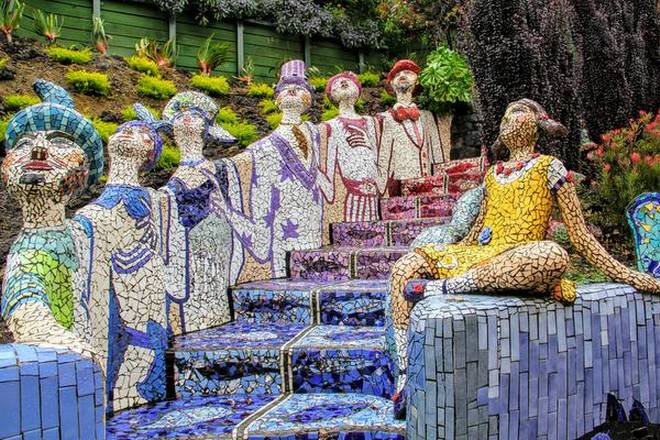The picture-book town in South Island is probably New Zealand’s last French touch
Rolling green hills dotted with sheep, bucolic farms, lakes studded with geese, mallard ducks and swans… The winding Highway 75 from Christchurch, New Zealand, is one of the most picturesque drives; after a couple of hours, we reach a harbour dotted with sailboats and a sea of whitewashed cottages.
I am in the sleepy harbour town of Akaroa, which translates as ‘Long Harbour’ in Maori, and was the site of the first French settlement in New Zealand. The town lies on a bay at the centre of the Banks Peninsula, off South Island.
The town is nestled in the caldera of an extinct volcano and feels quaintly French with names like Rue Jolie, Pompallier (after a French Bishop), Le Bons Bay, and Rue Benoit. “It’s a place where you must come to do nothing for a week,” says Shane Mitchell-Bathgate, who owns Akaroa Village Inn, just opposite the main wharf. “The only time this town of just under 700 people is busy is when a cruise ship docks, and tourists descend on the bars and restaurants,” he adds.
In the early 1800s Akaroa was a popular stop for whaling ships on the coast. In 1838, Captain Jean Langlois was so enamoured with the town that he thought of establishing a French colony here, and went back to France to get permission and settlers. By the time he returned two years later, with around 80 settlers, the locals had already signed the Treaty of Waitangi with the British, accepting their sovereignty. With no option, the colonists chose to stay back and integrate with the locals — building cottages, planting their roses, vines and lavender and creating a fusion of French and Maori culture.
Snapshots from Akaroa The charming town still retains its French roots | Photo Credit: Kalpana Sunder
Today, Akaroa looks like a film set, with one main street lined with small craft and art shops, fish and chips eateries, bakeries selling baguettes and confits, souvenir shops selling wooden Maori masks and carvings, gemstones, shimmering paua shell jewellery and kiwiana of every sort. The main wharf leads to the harbour filled with boats that do different cruises — from swimming with the rare Hector’s dolphins, to penguin-spotting trips and Black Cat cruises.
I walk through whitewashed, wooden gabled homes with gardens, the yellow-painted Langlois-Eteveneaux Cottage from 1843, a prefab from France, the graveyard dotted with the graves of pioneer settlers, and wooden St Peter’s Church. Many of the town’s homes are summer houses of people who live in Christchurch; many people have moved here after the devastating earthquake of 2011.
Every two years the town celebrates a French festival in the month of October, with French-inspired games, parades, stalls, food and entertainment. At the town’s small museum, I get a glimpse into its Maori, French and British history. Its walls are lined with black-and-white images of early settlers and exhibits from the town’s whaling past — from harpoons and lances to scrimshaw (the art of decorating and carving on whale bone). A show-stopper is a beautiful French cabinet made of local timber.
Come afternoon, I head to the harbour to catch sight of the rare Hector’s dolphins. Terns and gannets circle overhead in the grey skies as we sail past towering cliffs and rock formations like the Cathedral Cave, the same height as the Big Ben, where numerous sea birds nest, and Dan Rogers Cliff, where according to legend, a bank robber galloped off the cliff.
The water is a curious, opaque deep shade of blue, thanks to suspended volcanic ash. Steep hills border us on both sides with waterfalls, almost like a fjord, as we spy fur seals gambolling on the craggy rocks. A little ahead, we catch our first sight of dolphins leaping and surfing near our boat.
Back in town, I head to the hill-top home and studio of highly talented local artist, Josie Martin. Called The Giant’s House, it is an explosion of colour and imagery: Gaudi-meets-Dali with mosaic statues, flowers and cascading steps against the backdrop of the 1880s clapboard home. Josie, who looks every bit the eccentric genius — with blue hair and dark eye shadow — has combined her twin passions for horticulture and art to create this whimsical garden. I see shards of mosaic, old china, broken glass in huge sculptures and fountains. The house is today a B&B with themed rooms, its centrepiece being an ornate mahogany staircase imported from France.
Come evening, the streets empty out, and small dinner spots light candles on tables, serving fresh seafood, soups, and desserts. There is French-inspired cheese that is made at Barry’s Point as well as Chardonnay and Riesling from local wineries. I sit sipping wine at a waterfront café, and muse at what would have happened if Captain Langlois and the French had colonised the town.








